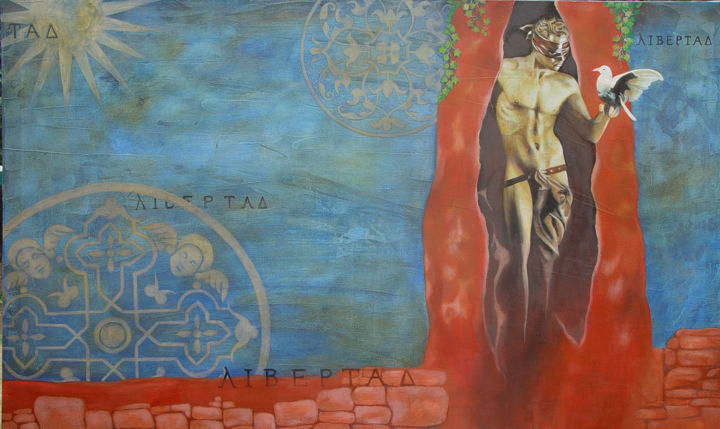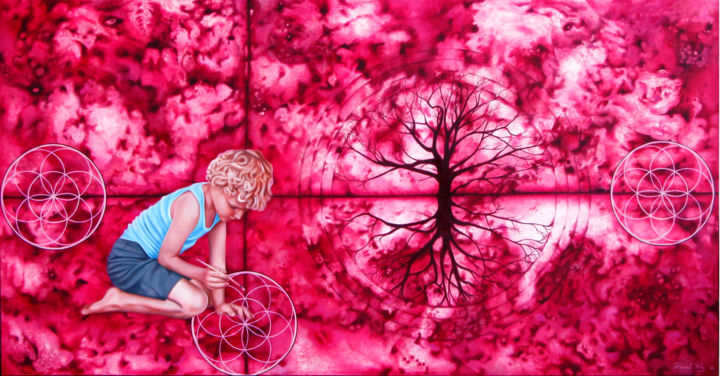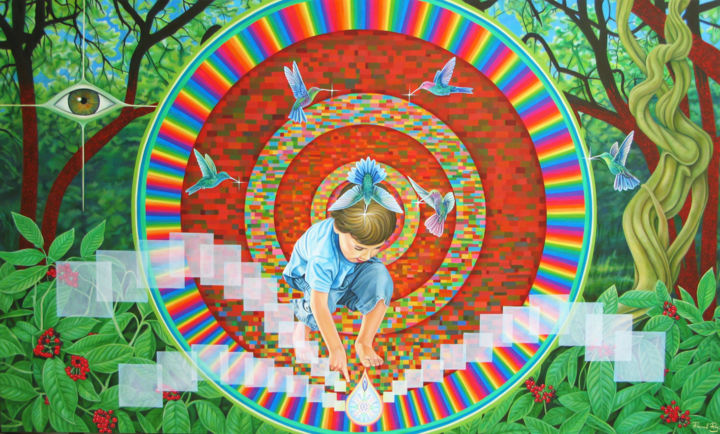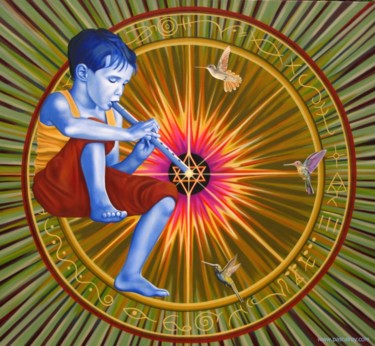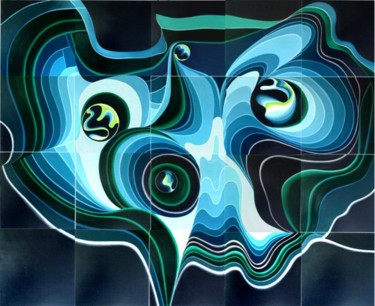Pascal Roy
The Surrealistic painter of Canadian origin Pascal Roy decided to live in Cuernavaca; perhaps the benign climate and natural beauty of the landscapes have become an incentive for its hedonism since the main purpose of Roy’s work of is to create a world of undeniable beauty. Surprising task that requires a strong dose of valence when all his contemporaries appear to have proposed a creation based on the dark side of life and an obvious lack of interest in technical plastic. Rather Pascal Roy uses technical language close to that of the Renaissance masters, while its themes are strongly linked to a modern point of view, in the worst sense of the word, "what is fashionable", slender and beautiful creatures, happy children and the whole paraphernalia of the New Age. A magnificent work of aesthetic pleasure that will attract the eyes searching for beauty.
Discover contemporary artworks by Pascal Roy, browse recent artworks and buy online. Categories: contemporary mexican artists. Artistic domains: Painting. Account type: Artist , member since 2008 (Country of origin Canada). Buy Pascal Roy's latest works on ArtMajeur: Discover great art by contemporary artist Pascal Roy. Browse artworks, buy original art or high end prints.

Artist Value, Biography, Artist's studio:
Pinturas del Pintor Pascal Roy • 19 artworks
View allEl pintor de origen canadiense Pascal Roy decidió vivir en Cuernavaca, talvez el clima benigno y la belleza natural de los paisajes se han convertido en un incentivo para su hedonismo. Porque el principal propósito del trabajo de Roy es crear un mundo de innegable belleza. Sorprendente tarea que requiere una fuerte dosis de valencia cuando todos sus contemporáneos aparecen haberse propuesto una creación basada en el lado oscuro de la vida y en un obvio desinterés por la técnica plástica.
Por el contrario Pascal Roy utiliza un lenguaje técnico cercano al de los maestros de Renacimiento, mientras sus temas están firmemente ligados a un punto de vista moderno, en el peor sentido del término; "aquello que está de moda", bellas y esbeltas criaturas, niños felices y toda la parafernalia del New Age.
Un magnifico trabajo de placer estético que seguramente atraerá la mirada de los buscadores de belleza.
Recognition
Exercises the profession of artist as a main activity
Biography
The Surrealistic painter of Canadian origin Pascal Roy decided to live in Cuernavaca; perhaps the benign climate and natural beauty of the landscapes have become an incentive for its hedonism since the main purpose of Roy’s work of is to create a world of undeniable beauty. Surprising task that requires a strong dose of valence when all his contemporaries appear to have proposed a creation based on the dark side of life and an obvious lack of interest in technical plastic. Rather Pascal Roy uses technical language close to that of the Renaissance masters, while its themes are strongly linked to a modern point of view, in the worst sense of the word, "what is fashionable", slender and beautiful creatures, happy children and the whole paraphernalia of the New Age. A magnificent work of aesthetic pleasure that will attract the eyes searching for beauty.
-
Nationality:
CANADA

- Date of birth : 1963
- Artistic domains: Works by professional artists,
- Groups: Professional Artist Contemporary Canadian Artists
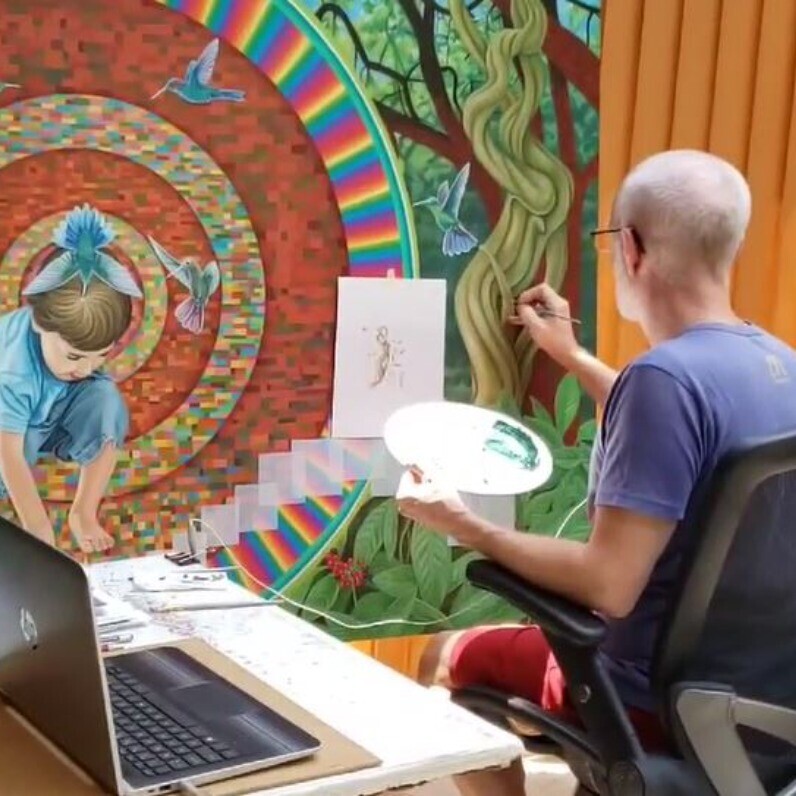
Ongoing and Upcoming art events
Influences
Education
Artist value certified
Achievements
Activity on ArtMajeur
Latest News
All the latest news from contemporary artist Pascal Roy
intrevista con el pintor Pascal Roy, habla de sua arte... su vida...
About Pascal Roy
The Surrealistic painter of Canadian origin Pascal Roy decided to live in Cuernavaca; perhaps the benign climate and natural beauty of the landscapes have become an incentive for its hedonism since the main purpose of Roy’s work of is to create a world of undeniable beauty. Surprising task that requires a strong dose of valence when all his contemporaries appear to have proposed a creation based on the dark side of life and an obvious lack of interest in technical plastic.
Rather Pascal Roy uses technical language close to that of the Renaissance masters, while its themes are strongly linked to a modern point of view, in the worst sense of the word, "what is fashionable", slender and beautiful creatures, happy children and the whole paraphernalia of the New Age.
A magnificent work of aesthetic pleasure that will attract the eyes searching for beauty.
FROM ARCHITECTURAL DESIGN TO FINE ART
Who's Who
The News
México City, November 19, 1999.
--------------------------------------------------------------------------------
PASCAL ROY
FROM ARCHITECTURAL DESIGN TO FINE ART
By EMANUEL DAVID WEINSTEIN
The News Staff Reporter
Pascal Roy, a native of Quebec, Canada, started painting only six years ago, after a career as an architectural designer, an artisan, and a Club Med activities organizer. Roy had a successful business designing and manufacturing gifts, but gave it up to explore the Caribbean and the free side of his spirit.
Walking away from comfort, luxury and popularity on his native turf, Roy figured that he needed a change if he was going to learn anything in life. His paintings are big, wondrous portraits of noble-looking men and women and a few scattered erotic androgyns. His technique of transferring a jigsaw puzzle of images into precise and accurate anatomy and proportion as a posed subject, is the first thing that the viewer notices. The News recently spent some time with Pascal Roy.
When you were a kid, did you have an idea that you wanted to draw, be an artist?
I've been drawing since I was very young. My father is a doctor, and my mother is a social worker, but both of them "practice" art in their spare time -- my mother paints, and my father makes sculptures, as well as paints. I have a sister who is a great painter, but she does not paint ... she's an engineer ... a nuclear engineer (laughter). She draws very well even though she's never taken classes. But she's saving that for later; her career as an artist. My other sister and my brother also want to wait, they want to make a living first. I do not want to wait until I'm a millionaire.
When did you decide on going into architectural design?
I used to draw a lot of houses when I was young. I don't remember when I started, probably from the time I could take a pen in my hand. I don't know of a precise time when I knew (what I wanted to do). But I knew about architecture, about perspective. I looked through books, studying perspective. So maybe around the age of twelve or thirteen, I knew how to handle perspective ... making two points -- vanishing points. So, I started to design my houses and buildings. But I got frustrated a little bit as an architect, because in Quebec, there's not much of a budget, people do not have too much of a budget to do something wild, do something more artistic in architecture. Usually, they (architects) are following the plans that are very similar to the plans that were used for the last house. So, as an architect I was a little bit frustrated, especially since I wanted to be an architectural designer. This is why I went into stage/set design. On stage you can do the interior of a house or building, you can do anything, depending on the show.
You came down here to work at the Club Med, right?
Yes. I was a set designer first at Club Med. I interviewed on my birthday. At the end of the interview they told me I was hired. They sent me to the Bahamas for two months to be set designer. The job actually was very dangerous. They would give me a five-meter ladder, and tell me to decorate the stage ... alone. I had to take up heavy curtains -- with a very unsteady ladder. After two months I told them that I did not want this job, could they offer me something else. That's when I was sent to another Club in the Caribbean, where they taught me how to make paintings on silk fabric. I spent a few weeks there and then headed back to Quebec, where they assigned me to the Club Med in Ixtapa where I taught guests how to paint on silk.
They taught you a technique you had never used before?
Uh huh, but for me it was very easy. I started to make some discoveries, modifying these techniques. I only taught for six months, it was supposed to be for one year, but the Club Med closed after only six months. A lot of my friends who worked at the Club as GO's lived in Mexico, so that gave me the spark to go and try and live in Mexico City. I thought this could be good opportunity, a chance to go see what's up in Mexico City. I'm still here after six years.
You met David (Sonsino), your representative here. How did the idea of having David represent you and sell your art come about?
David was working as a decorator for a store here in the Zona Rosa at the time. But he was getting less and less contracted work over time. I was making more and more paintings. David just by himself started taking care of things. I'm not very good at business, people would ask, "Can I have that?" and out of pity I'd say, "Take it." Dave would jump in the middle and say, "No, he wants this much for it ... " He'd get a good price and make sure I was making money from my work. That's how he took his place. The place where he was working through does not telephone him anymore with any jobs, so he is now mainly my representative.
He's been my rep four years, now.
Things have worked out pretty well since then?
Half of my work is sold; I made about fifty works up until now. In five years, I've sold half my work.
You have big canvases, the buyer is getting a lot of visuals for the price, eh?
I base my the price on what I do because I usually spend about one month, more or less, one just one painting. I would like to receive at least one month's minimum wage, in dollars for what I do. I calculate the amount of time I spend on a painting, its value to me. I add that all up and make a price. Of course, in my heart, the price should be much higher but I have to make living, and I have to adjust my prices to a certain market ... the market in Mexico. I do not think like many other artists, but do I hope one day I can get the best price for my art. Don't print that.
Why not? You are absolutely entitled to get what your art is worth. If some day the market (for your art) is bigger than the supply, the market will pay what the market will bear.
What I hear from other artists is that they are not on the economic side, they try not to get involved in the economic side. They mostly sit around on their thrones and feel so proud of what they do, and they don't want to talk about price, that comes way, way behind the work. Maybe I think differently -- the economic side is important.
What inspires your evocation of the medieval, Baroque and Renaissance?
There is a painter's work I like a lot, his name is Lucas Cranach. He's a German who lived in the last part of the Baroque style as it went into the Renaissance. He used to paint a lot of naked women with red hair, like I do. My first real painting on canvas was inspired by one of his paintings, and I'' still inspired by his style.
The Baroque style is where art was being developed using perspective. Art was at its most primitive. You can see this in the works of Lucas Cranach. It was a period where art was growing, and you can see this and feel this in the artworks (of the period). It is a little bit of what I want to pass in my art. It was that type of baroque style that is being done now, in my paintings today.
--------------------------------------------------------------------------------
[Home Page]
Exposiciones
Expositions
Sala Ismael Rodríguez del sindicato de trabajadores del IMSS " Libertad " exposición pictórica, individual-México DF , oct 1996
Galería Oscar Román, México DF, Dec 1997
Segundo Aire, individual- México DF, nov 1997
29th Art fair, the American school fondation. México DF, Nov 1998
Club de golf Bellavista, individual México DF 1998
Subasta de arte, Casa Pedro Domecq, México DF, feb.1998
Gallería S.Menache, individual-México DF sep,1999
El Principio, individual-México DF, 1999
El Ciruelo, individual-Tepostlan, México, dic 2000
Zsazsa ,individual-México DF, enero 2000
Galería Punto 1(uno)diseño, individual- México DF, 2001
Arte Colibrí, Cuernavaca, mars 2002
Centro Cultural, El Gallinero, individual- Cuernavaca, México, jul,2002
Galería Taboo, individual- Puerto-Vallarta, México, Nov 2002
Vucceria, individual-México DF 2002-2003
Galerie Saint-Dizier, Montreal, Canadá, jul 2003
Galería Artemis, México DF, nov 2003
Galería Santa Nooka, Valle de Bravo, México, dic 2003
Galería Cenquizqui, Cuernavaca, México, 2003
Galería Punto 1(uno)diseño, individual- México DF ,2003
Galería Aura, México DF, 2004
Misión del Sol (SPA Hotel), Morelos, 2005
Centro Cultural, La Tallera, Museo David Alfaro Siquieros, Cuernavaca, 2006
Centro Cultural Metropolitano Tampico, Tampico, 2007-2008
oil on canvas and mix medium The Surrealistic painter of Canadian origin Pascal Roy
oil on canvas, acrylic



